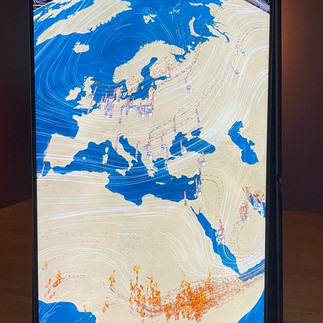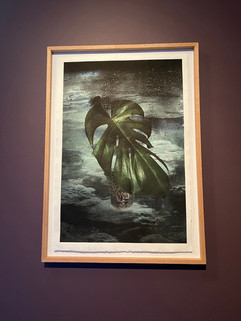World Wind - Making the Invisible Climate Visible
- Dror Margalit
- Feb 1, 2023
- 2 min read
It is a lovely Saturday afternoon in the Lower East Side. The area is peaceful. Some people are playing basketball, and others run in the park below Houston Street. Like many other beautiful days such as this, the processes that affect today's climate emergency do not bother most of my consciousness. This, however, is about to change as I enter the bitforms gallery to see World Wind by Marina Zurkow.
As I enter the space, I pay little to no attention to the objects placed on the table to my left. Those will gain a new meaning on my way out, but first, I go to the center of the room to see The Breath Eaters: three screens displaying global carbon emissions. Around me, there are mashups of images situated in different environments. A closer look at each of them paints a profound picture of our current climate.
One thing I appreciate most about this exhibition is that it made the unseen seen. Our atmosphere, along with the Co2 in it, is invisible, making humans' effect on it be perceived as an abstract issue that happens "out there." Yet, when looking at The Breath Eaters, it is hard to think about it in that way. Zurkow visualized the emission of carbon into the atmosphere and its flow. In doing so, she presented how the factories in the US can affect Africa, how wildfires can worsen the climate emergency, or where much of the carbon in the carbon is accumulated,
Additionally, focusing on the entire world brings attention to the global aspect of the carbon emission problem. For example, I was initially surprised to see how relatively few factories are in the US. A quick look at China, however, suggests that much of the carbon emissions in the world simply moved there (i.e., items that are consumed in the US might be made in China). The Breath Eaters' global perspective allows us to see that for richer countries, it is not enough to reduce emissions. Instead, they need to invest resources in helping the world to move to more sustainable energy sources. Last, I appreciated that the piece generated life, showing how carbon emissions are generated globally constantly.
When I looked around the gallery, I saw ordinary items situated in a larger environment, strengthening the ties Zurkow created between us and the environment. The items were disproportionate to the size of the environment, presenting a bowl or a plant larger than the clouds or the desert. This made me think of the items we value in the world and their impact on the environment.
As I exited the exhibition, I looked again at the items by the entrance. Now I realize that they are related to the collages inside. Now, they made the unseen damages of humans on the environment seen.


















Comments